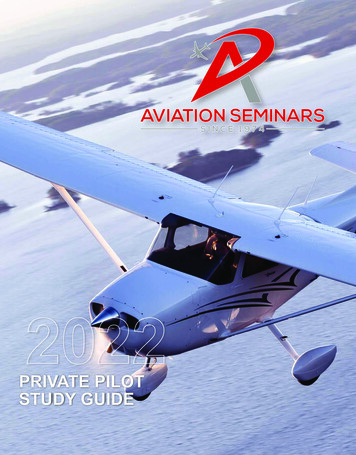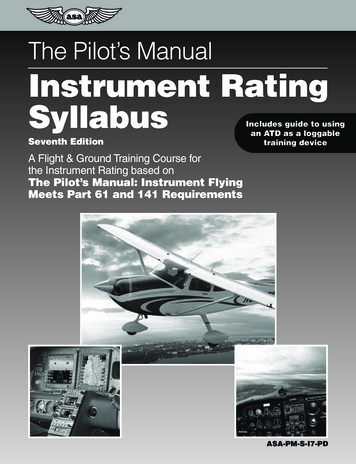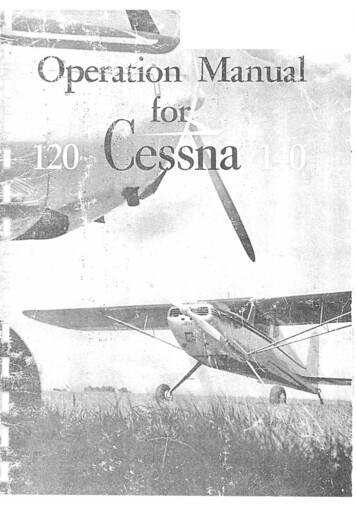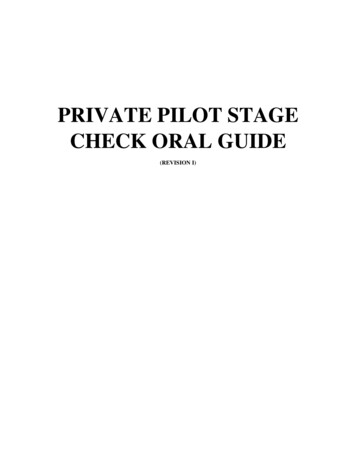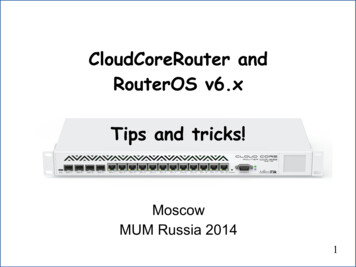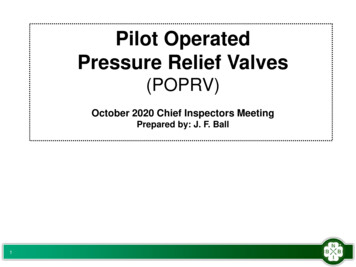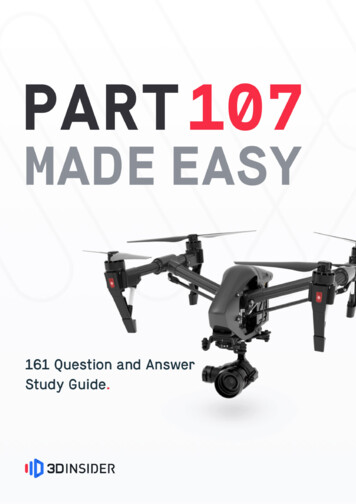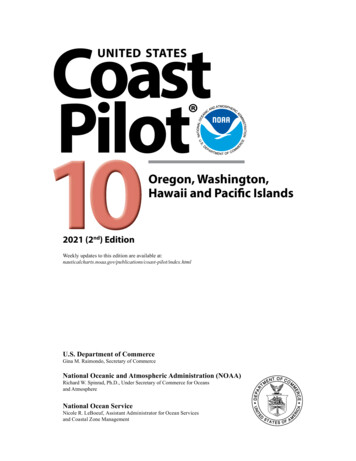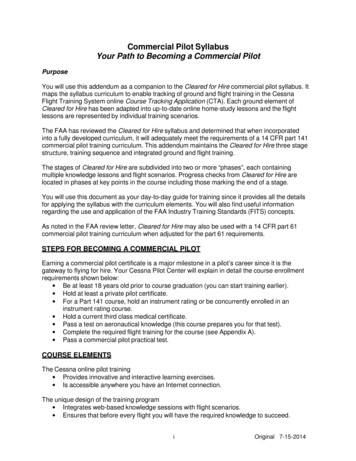
Transcription
Commercial Pilot SyllabusYour Path to Becoming a Commercial PilotPurposeYou will use this addendum as a companion to the Cleared for Hire commercial pilot syllabus. Itmaps the syllabus curriculum to enable tracking of ground and flight training in the CessnaFlight Training System online Course Tracking Application (CTA). Each ground element ofCleared for Hire has been adapted into up-to-date online home-study lessons and the flightlessons are represented by individual training scenarios.The FAA has reviewed the Cleared for Hire syllabus and determined that when incorporatedinto a fully developed curriculum, it will adequately meet the requirements of a 14 CFR part 141commercial pilot training curriculum. This addendum maintains the Cleared for Hire three stagestructure, training sequence and integrated ground and flight training.The stages of Cleared for Hire are subdivided into two or more “phases”, each containingmultiple knowledge lessons and flight scenarios. Progress checks from Cleared for Hire arelocated in phases at key points in the course including those marking the end of a stage.You will use this document as your day-to-day guide for training since it provides all the detailsfor applying the syllabus with the curriculum elements. You will also find useful informationregarding the use and application of the FAA Industry Training Standards (FITS) concepts.As noted in the FAA review letter, Cleared for Hire may also be used with a 14 CFR part 61commercial pilot training curriculum when adjusted for the part 61 requirements.STEPS FOR BECOMING A COMMERCIAL PILOTEarning a commercial pilot certificate is a major milestone in a pilot’s career since it is thegateway to flying for hire. Your Cessna Pilot Center will explain in detail the course enrollmentrequirements shown below: Be at least 18 years old prior to course graduation (you can start training earlier). Hold at least a private pilot certificate. For a Part 141 course, hold an instrument rating or be concurrently enrolled in aninstrument rating course. Hold a current third class medical certificate. Pass a test on aeronautical knowledge (this course prepares you for that test). Complete the required flight training for the course (see Appendix A). Pass a commercial pilot practical test.COURSE ELEMENTSThe Cessna online pilot training Provides innovative and interactive learning exercises. Is accessible anywhere you have an Internet connection.The unique design of the training program Integrates web-based knowledge sessions with flight scenarios. Ensures that before every flight you will have the required knowledge to succeed.iOriginal 7-15-2014
You and your instructor will discuss the schedule for your training and you will know When to complete the appropriate web-based knowledge instruction What to prepare for each flight scenario.Upon completion of each flight scenario you and your instructor will Review the elements of the flight scenario and the scenario outcome. Compare your performance to the completion standards. Independently evaluate the tasks in the flight scenario. Discuss and compare the results. Discuss the next flight scenario.Please note that it may take you more than one flight to complete a flight scenario to theestablished standards.COURSE STRUCTURESTAGESThe course is divided into three stages: Stage 1: Cross-Country, Night and Maneuvers Review Stage 2: Complex Airplanes and Commercial Pilot Maneuvers Stage 3: Commercial Pilot Practical Test PreparationPHASESEach stage is divided into phases. There are a total of eight phases:Stage 1: Cross-Country, Night and Maneuvers ReviewPhase 1: Learning Professional Cross-Country and Night ProceduresPhase 2: Refining Navigation and Basic Maneuver SkillsPhase 3: Building Cross-Country ExperienceStage 2: Complex Airplanes and Commercial Pilot ManeuversPhase 4: Flying Complex AirplanesPhase 5: Flying Commercial ManeuversStage 3: Commercial Pilot Practical Test PreparationPhase 6: Preparing for your Commercial Pilot CheckridePhase 7: Fine Tuning SkillsPhase 8: Achieving Your GoalSCENARIOSThere are multiple flight scenarios within each phase. The completion standards for the scenariotasks in each phase are found in that phase’s Phase Proficiency Checklist.Once all items on the phase proficiency checklist are completed to the level of performancerequired for that phase, you can then move on to the next phase of training.You are not required to complete every flight scenario within a phase, but it is highlyrecommended that you do so, as the scenarios progress in complexity to give you maximumefficiency in your training. Progress Checks are required scenarios.2Original 7-15-2014
iOriginal 7-15-2014
PROGRESS CHECKSEach stage has at least one Progress Check at the end of the last phase of each stage. Theprogress checks are found: Stage 1, phase 2 Stage 1, phase 3 Stage 2, phase 4 Stage 2, phase 5 Stage 3, phase 8PHASE SEQUENCEThe eight phases are:1. LEARNING PROFESSIONAL CROSS-COUNTRY AND NIGHT PROCEDURES— In this phase you will review and gain experience in cross-country planning andexecution, using electronic, pilotage, and DR navigation. You will control the aircraftand navigate referring only to the flight instruments and recover from unusual flightattitudes without looking outside. You will also perform recovery from power off andpower on stalls.2. REFINING NAVIGATION AND BASIC MANEUVER SKILLS — Here you willexamine ADF and VOR systems and the use of RMI and HSI presentations. You willalso refresh and sharpen your understanding of the different types of airspace andthe operating considerations. You will also add to your cross-country experienceexercising both visual and electronic navigation skills as well as those involved withshort field and soft field takeoffs and landings. And finally, you will fly with anotherinstructor for a progress check.3. BUILDING CROSS-COUNTRY EXPERIENCE — In this phase you will expandyour knowledge of weather theory and the reports, forecasts and charts used forpreflight planning. You will also dig deeper into weight and balance concepts,calculations, proper loading, and CG changes due to fuel burn. In flight you willcontinue to build cross-country experience including a long flight with one leg thathas a straight line distance of more than 250 nm, and you will complete anotherprogress check.4. FLYING COMPLEX AIRPLANES — Your knowledge concentration in this phaseincludes aerodynamic topics of stability, rate and radius of turn, CG effect on spinsand load factor. You will also explore airspeed limitations and aerodynamic hazardsincluding high-speed flight. Your flight scenarios involve using a complex airplane fornormal operations, slow flight, stalls, instrument maneuvers and recovery fromunusual attitudes. This phase is completed with a progress check.5. FLYING COMMERCIAL MANEUVERS — In this phase, you will becomeknowledgeable about and then perform the commercial performance and groundreference maneuvers of Steep Spirals, Chandelles, Lazy Eights, Eights on Pylons,and Power-off 180 accuracy approaches. You will also study the environmentalfactors and review techniques for calculating aircraft performance under differentconditions. You will wrap up this phase by completing a progress check.6. PREPARING FOR YOUR COMMERCIAL PILOT CHECKRIDE — In this phase, you willstudy concepts involved with specialized operations, hazards, engines and propellers,3Original 7-15-2014
aeromedical factors, and key topics in the Aeronautical Information Manual. In flight, you willrefine your skill with Commercial Pilot maneuvers and expand your proficiency and riskmanagement skills involving cross-country operations.7. FINE TUNING SKILLS — Here you will review the general Federal AviationRegulations and become familiar with those more closely associated withCommercial operations. In flight, you will hone your skill with Commercial Pilotmaneuvers and complete the final cross-country of this course.8. ACHIEVING YOUR GOAL — In this final phase you will learn tips for making yourcheckride go more smoothly, and ways to manage the risks unique to being acommercial pilot. You will also review the commercial pilot flight maneuvers andparticipate in a one-on-one pre-check ride briefing with your instructor. You willcomplete the course with the Final Progress Check.Since each phase builds on what you have learned before, it is important that you complete thephases in the proper sequence. However, some degree of flexibility is necessary. Weather and other factors may make it impractical to conduct a particular flight scenariowhile another may be possible. In this case your instructor, with the approval of the chief instructor, may suggest out-ofphase and out-of-stage scenarios that can be completed with the current conditions. If available at your flight school and approved for this course, you may complete all orportions of a flight scenario using an aviation training device, flight training device, orflight simulator.IMPORTANT: The syllabus does not address your local Cessna Pilot Center’s safety practicesand procedures; review these key items before or after the first flight with your instructor.PHASESThere are 8 phases of training. Each phase has Required Web-based Knowledge Instruction Suggested Flight Scenarios Required Phase Ground Training Checklists Required Phase Proficiency ChecklistsWeb-based Knowledge Instruction Forms the customer’s knowledge foundation to be used for the flight scenarios Is directly correlated to the phase Is to be completed before the corresponding phase can be considered completeFlight Scenarios Are placed in a suggested order of completion Can be flowno Onceo More than onceo Not at all Can be customized to for your local training environment Can be completed out of phase or stage if approved by the Chief or Assistant ChiefInstructor4Original 7-15-2014
Phase Ground Training Checklists Can be prepared for through study of the web-based curriculum and course librarymaterialso Including FAA publications such as the Pilot’s Handbook of AeronauticalKnowledge and Airplane Flying Handbooko Recorded as ‘Instruction Given’, ‘Describe’ or ‘Explain’‘Instruction Given’ indicates that your instructor briefed you on the subject‘Describe’ indicates that you are able to describe the physical characteristicsof the maneuver or knowledge area‘Explain’ indicates that you are able to describe the task or knowledge areaand understand the underlying concepts, principles and procedureso Must be demonstrated to the ‘Explain’ level to complete the phasePhase Proficiency Checklists Contain tasks that are to be completed in order to the ‘Perform’ level in order tocomplete the phase Contain single-pilot resource management that is to be completed to the‘Manage/Decide’ levelo Grading criteria is discussed in detail later in this document Contain completion standards for the phasePROGRESSING THROUGH THE SYLLABUSA phase is considered complete when all the tasks are completed to the ‘Perform’ or‘Manage/Decide’ level as appropriate for the completions standards given on the PhaseProficiency Checklist.It is recommend that the order of the suggested scenarios be followed. However, with the approval of your Chief or Assistant Chief Instructor you can completescenarios that are out of the current phase This flexibility allows greater efficiency in course of flight trainingYou do not need to complete all scenarios in a phase in order to complete that particular phase.The scenarios are simply suggested flights to get you to the ‘Perform’ and ‘Manage/Decide’ levelfor the tasks and standards for that phase.It is more common to repeat the scenarios in order to obtain the desired level of proficiency andsafety than to skip them.If you are able meet all of the phase standards and skip a scenario, you and your instructormust make sure that you meet the hourly training requirements if they are applicable to yourapproved training course. It is possible that you could finish up the course and have to make uptime at the end.5Original 7-15-2014
OVERALL SYSTEM USEThe Cleared for Hire—Commercial Pilot course is designed to provide the most benefit when The instructor assigns preparation for the next scenarioo Web-based studyo Suggested study materialso Scenario planning Prior to the next scenario, youo Study the assigned materialso Print a Phase Progress Report for your training records at the airporto Perform the necessary scenario planning Prior to the flight, the instructoro Prints your training package including thePhase Ground Training ChecklistPhase Proficiency ChecklistScenario During the preflight briefingo Your instructor reviews the Phase Progress Report you provide and evaluatesthe applicable items on the Phase Ground Training Checklisto You ask any questions you may have and clarify your understanding of theknowledge areas and the upcoming scenario you will fly and brief the instructoron the scenario planning During the postflight briefingo You independently grade the applicable tasks on the Phase Proficiency Checklisto Your instructor independently grades the tasks on the Phase ProficiencyChecklisto You then discuss the scenario outcome and compare gradingo The instructor logs the scenario into the Course Tracking Application on thecomputer at your Cessna Pilot CenterFAA INDUSTRY TRAINING STANDARDS (FITS)This flight training syllabus uses the concepts developed under the FAA Industry TrainingStandards (FITS) program. FITS incorporates three tenets Scenario-based training (SBT) Single-pilot resource management (SRM) Learner-centered grading (LCG)Scenario-Based Training (SBT) uses real-world scenarios as the foundation of training. Flightmaneuvers are still a vital part of flight training, but the use of real-world scenarios help todevelop a pilot’s decision making skills. The training presents situations and circumstances thatpilots face every day as learning experiences.6Original 7-15-2014
Single-Pilot Resource Management (SRM) includes the concepts of aeronautical decisionmaking (ADM), risk management (RM), task management (TM), automation management (AM),controlled flight into terrain (CFIT) awareness, and situational awareness (SA). SRM traininghelps the pilot to accurately assess and manage risk, thereby making logical and timelydecisions.Learner-Centered Grading (LCG) includes two parts: learner self assessment and a detaileddebrief by the instructor. The purpose of the self assessment is to stimulate growth in thelearner’s thought processes and, in turn, behaviors. The self assessment is followed by an indepth discussion between the instructor and the customer that compares the instructor’sassessment to the customer’s self assessment.SCENARIO-BASED TRAININGThe scenario-based approach to training pilots emphasizes the development of critical thinkingand flight management skills, rather than focusing solely on traditional maneuver-based skills.The goal of this training philosophy is the accelerated acquisition of higher-level decisionmaking skills. Such skills are necessary to prevent pilot-induced accidents.Scenario-based training goals include the development of Critical thinking skills Aeronautical decision making skills Situational awareness Pattern recognition (emergency procedures) and judgment skills Automation competence Planning and execution skills Procedural knowledge Psychomotor (hand-eye coordination) skills Risk management skills Task management skills Automation management skills Controlled flight into terrain (CFIT) awarenessFor scenario-based training to be effective there must be a purpose for the flight andconsequences if the flight is not completed as planned.It is vital that you, the pilot in training, and the instructor communicate the following informationwell in advance of every training flight: Purpose of the flight Pressures to complete the flight (real or simulated) Risks/hazards associated with the scenario (real or simulated) Scenario destination(s) Desired outcomes Possible in-flight scenario changes or deviations (during later stages of the program)With the guidance of your instructor, you should plan and fly the scenario as realistic aspossible. This means that you will know where you are going and what will transpire during the7Original 7-15-2014
flight. While the actual flight may deviate from the original plan, this method allows you to beplaced in a realistic scenario.SCENARIO PLANNINGPrior to the flight, you will be briefed on the scenario to be planned. You will plan the scenario;your instructor will help you the first few times. The flight scenario should include Simulated real-world reason to go flying Routeo Destination(s)o Weathero NOTAMs Pressures to complete the flight (real or simulated) Risks associated with the scenario (real or simulated) Possible deviationsReality is the ultimate learning situation, and scenario-based training attempts to get as close aspossible to this ideal. The more realistic the training scenario, the better we learn Core safety habits, and Decision-making skills that can be applied in the real-worldSINGLE-PILOT RESOURCE MANAGEMENT (SRM)Single-pilot resource management is defined as the art and science of managing all theresources (both onboard the aircraft and from outside sources) available to a pilot flying in asingle-pilot operation (prior to and during flight) to ensure that the successful outcome of theflight is never in doubt.SRM includes the concepts of Task management (TM) Automation management (AM) Risk management (RM) Aeronautical decision making (ADM) Situational awareness (SA) Controlled flight into terrain (CFIT) awarenessSRM training helps a pilot maintain situational awareness by Managing the technology in the aircraft as well as aircraft control and navigation tasks Enabling the pilot to accurately assess and manage risk while making accurate andtimely decisions Helping pilots learn how to gather information, analyze it and make decisionsIn most flight scenarios, there is no one correct answer. Pilots are expected to analyze eachsituation in light of their Experience level Personal minimums Current physical and mental condition Ability to make their own decisions as best as possible8Original 7-15-2014
Below are standards for each training concept of SRM:PerformanceThe training task is:StandardsYou will:Task management (TM)Prioritize and select the most appropriate tasks (orseries of tasks) to ensure successful completion ofthe training scenario.Automation management (AM)Program and utilize the most appropriate and usefulmodes of cockpit automation to ensure successfulcompletion of the training scenario.Risk management (RM)Utilize risk management tools to assess and mitigaterisk associated with the planned flight both during thepreflight planning and in flight.Aeronautical decision-making (ADM)Consistently make informed decisions in a timelymanner based on the task at hand and a thoroughknowledge and use of all available resources.Situational Awareness (SA)Be aware of all factors such as traffic, weather, fuelstate, aircraft mechanical condition, and pilot fatiguelevel that may have an impact on the successfulcompletion of the training scenario.Controlled Flight Into Terrain (CFIT)AwarenessUnderstand, describe, and apply techniques to avoidCFIT during inadvertent encounters with IMC duringVFR flight, periods of reduced visibility, or at night.LEARNER-CENTERED GRADINGLearner-centered grading includes two parts Learner self-assessment A detailed debrief by the instructorThe purpose of the self-assessment is to stimulate growth in the learner’s thought processesand, in turn, behaviors. The self-assessment is followed by an in-depth discussion between youand your flight instructor that compares your self-assessment to the instructor’s assessment.Pre- and postflight briefings are essential for setting goals. During events and tasks that requirehigh levels of attention, there may be little time for learning as the bulk of your cognitiveresources are given to performing the actual task.9Original 7-15-2014
INDEPENDENTLY GRADING THE SCENARIOAfter the scenario is complete, you and your instructor should independently grade yourperformance for maneuvers and single-pilot resource management (SRM). Note that any gradethat would not apply to the task has been grayed out in this syllabus.It is very important that enough time is allowed. Simply assigning grades and signing logbookswithin a limited period of time will not work with this grading system.After independently evaluating the actual scenario outcomes compared to the desired outcomes You and your instructor come together to compare and discuss your individualevaluations during the postflight discussionYou and your instructor may disagree on the evaluations. This should be used as an opportunity to discuss the scenario further The instructor has the final authority in assigning the final grade for the desiredoutcomesMANEUVER (TASK) GRADES Describe – At the completion of the ground training session, the pilot in training will beable to describe the physical characteristics of the task at a rote level. Explain – At the completion of the ground training session, the pilot in training will be ableto describe the task and display an understanding of the underlying concepts, principles,and procedures. Practice – At the completion of the scenario, the pilot in training will be able to plan andexecute the scenario. Coaching, instruction, and/or assistance from the instructor willcorrect deviations and errors identified by the instructor. Perform – At the completion of the scenario, the pilot in training will be able to perform theactivity without assistance from the instructor. Errors and deviations will be identified andcorrected by the customer in an expeditious manner. At no time will the successfulcompletion of the activity be in doubt. (‘Perform’ will be used to signify that the pilot issatisfactorily demonstrating proficiency in traditional piloting and systems operationskills.) Not Observed – Any event not accomplished or required in the scenario.Example: Once the pilot in training can explain the effect of crosswind and speed reduction onrudder effectiveness, they have achieved a level of learning that will allow formeaningful “Practice.” The “Perform” level is met when the completion standards for the particular scenarioor phase are met.10Original 7-15-2014
SINGLE-PILOT RESOURCE MANAGEMENT (SRM) GRADES Explain – At the completion of the ground training session, the pilot in training can verballyidentify the risks inherent in the flight scenario. Practice – The pilot in training can identify, describe, and understand the risks inherent inthe scenario. The customer may need to be prompted to identify risks and makedecisions. Manage/Decide - The pilot in training can correctly gather the most important dataavailable both within and outside the cockpit, identify possible courses of action,evaluate the risk inherent in each course of action, and make the appropriate decision.Instructor intervention is not required for the safe completion of the flight. Not Observed – Any event not accomplished or required in the scenario.Example: A pilot who is becoming proficient at aeronautical decision making (ADM) andrisk management (RM) would be graded first at the “Practice” level. The “Manage/Decide” level is met once a pilot makes decisions on their own, forinstance, the decision to go-around without being prompted.EVERYDAY USE OF FITS CONCEPTSThe PAVE ChecklistUse the PAVE Checklist as an easy way to implement the FITS concepts.The PAVE checklist is A simple way to remember and examine the risk factors before you fly, and Can also help you manage the specific risks associated with taking off and landingThe PAVE checklist puts risk factors into four categories:PilotAircraftenVironmentExternal pressuresThe pilot. Are you fatigued? When was the last time you were flying in the weather conditionsthat you will encounter? What are your personal minimums?The aircraft. Are you familiar with the aircraft? Its avionics? Is it airworthy? What is the densityaltitude? How does that affect your climb rate? What is your maximum crosswind component?The environment. Are the temperature and dew point close? Are you familiar with the area andits topography? Are there any NOTAMs?External pressures. Are others influencing the flight? Do you have people waiting for you at theairport?11Original 7-15-2014
KNOWLEDGE CONTENTWEB-BASED KNOWLEDGE INSTRUCTIONThe web-based knowledge instruction should be completed before beginning the flightscenarios in each corresponding phase; you can work ahead as far in the course as you like atyour discretion. However, the course is designed so that the web-based knowledge instructioncorresponds to the flight scenarios within a phase.If you have an extended time lapse between studying the web-based knowledge instruction andflying the companion scenario, you will find it very helpful to take some time to review your lastknowledge sessions just before you fly the associated scenario.You complete the web-based knowledge instruction satisfactorily by answering all the questionscorrectly. Your instructor will Review your results before you fly Answer any questions you may haveEXPANDED BRIEFINGSBefore each significant event in your flight training you will receive an expanded briefingscheduled by your instructor. This briefing ensures that all goes as smoothly as possible foryour First solo flight First solo cross-country flight FAA practical testDuring these expanded briefings, your instructor will ask you questions about your airplane andthe local flight environment as well as questions specific to the phase of training you have justcompleted.These briefings will be conducted one-on-one with your instructor and can be found in Appendix A.SUGGESTED KNOWLEDGE REVIEW SESSIONSTo fine tune your knowledge, there are suggested knowledge review sessions associated witheach stage of training. These are designed to be an optional supplement to the web-basedknowledge instruction and are conducted one-on-one with your instructor.Feel free to ask your instructor questions. Your instructor is there for you and your success. Thesuggested knowledge review sessions can be found in Appendix B of the syllabus.KNOWLEDGE TESTCessna’s online pilot training includes an FAA question review feature which Contains examples of FAA knowledge test questions Provides the answers and explanations of the correct and incorrect answer choices Prepares you to take a CPC practice test and the FAA knowledge test12Original 7-15-2014
Upon completing Phase 7, you will want to prepare for and take the FAA knowledge test. As apart of your preparation, your Cessna Pilot Center (CPC) will likely want you to take a practicegraded test as a part of their course. The CPC test Has questions covering the required FAA knowledge areas Counts as your CPC final exam for the course. Is taken and proctored at your Cessna Pilot Center using the randomly generated examfeature of the Question Review in your course by selectingo Practice Examso Randomly Generated Examo Start New, ando If previous random exams taken, select OK to overwrite previous resultsWhen you have completed all the questions in your CPC knowledge test Select “Finish / Suspend” Select “Finish”, and then Your proctor willo Select View Exam Resultso Print the Exam Results Summary, ando Select View Exam Detail and note any question not answered correctlyWhen you have finished the test, your instructor will Review the results with you. Assign appropriate areas for review if necessaryAfter taking the CPC knowledge test you should then take the FAA knowledge test as soon aspossible, as the information will be fresh in your memory.FLIGHT SCENARIOSPREFLIGHT BRIEFINGBefore each flight scenario you and your instructor will review the scenario objectives to makesure you both understand what you will be doing during the lesson. Use this opportunity to ask any questions. Make sure you understand what is expected of youDUAL FLIGHTSA dual flight is one performed with your instructor. A scenario conducted as a dual flight willusually begin with a review of tasks from previous flights, and then new tasks will be introduced.This will help you to see the relationships between what you have previously learned and thenew tasks to be performed on the flight.For dual flights, (IR) means “instrument reference,” or reference to the flight display orinstruments only. You will need a view-limiting device such as a hood or view-restricting glasses for ascenario having (IR) associated with any taskSOLO FLIGHTSBefore your solo flights, you and your instructor will agree on The assigned destination and route What you should accomplish during the flight Any additional requirements Any limitations regarding weather and airspace13Original 7-15-2014
PIC FLIGHTSPilot in Command (PIC) flights are flights that can be flown solo or as PIC with other individualsaboard (i.e. fellow pilots in training) per your flight schools policies and approved course. Againyou and your instructor will agree on The assigned destination and route What you should accomplish during the flight Any additional requirements Any limitations regarding weather and airspacePOSTFLIGHT DISCUSSION AND EVALUATIONAfter each flight, you and your instructor will Review your flight and evaluate your performance independently Compare and discuss your self-evaluation with his or her evaluationYour instructor will make recommendations to help you in your learning. Make sure you askquestions about any area that is not clear.You will then complete your flight training record based on the completion standards for thephase. Any tasks requiring additional pr
gateway to flying for hire. Your Cessna Pilot Center will explain in detail the course enrollment requirements shown below: Be at least 18 years old prior to course graduation (you can start training earlier). Hold at least a private pilot certificate. For a Part 141 course, ho

